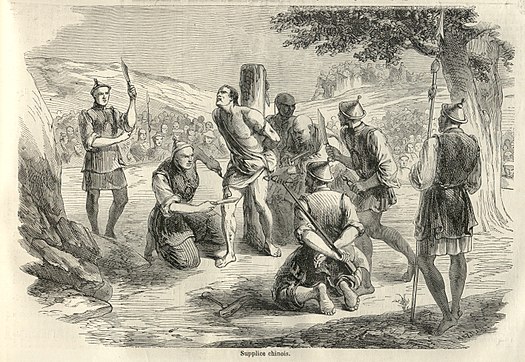Well the Chinks are the 'bestest' when it comes to torture though
https://en.wikipedia.org/wiki/Lingchi
Lingchi (
Chinese: 凌遲), translated variously as the
slow process, the
lingering death, or
slow slicing, and also known as
death by a thousand cuts, was a form of torture and
execution used in
China from roughly 900 CE until it was banned in 1905. It was also used in
Vietnam. In this form of execution, a knife was used to methodically remove portions of the body over an extended period of time, eventually resulting in death.
Description[edit]
The process involved tying the condemned prisoner to a wooden frame, usually in a public place. The flesh was then cut from the body in multiple slices in a process that was not specified in detail in Chinese law, and therefore most likely varied. The punishment worked on three levels: as a form of public humiliation, as a slow and lingering death, and as a punishment after death.
According to the
Confucian principle of
filial piety, to alter one's body or to cut the body are considered unfilial practices.
Lingchi therefore contravenes the demands of filial piety. In addition, to be cut to pieces meant that the body of the victim would not be "whole" in spiritual life after death. This method of execution became a fixture in the image of China among some Westerners.
[3]
Lingchi could be used for the torture and execution of a living person, or applied as an act of humiliation after death. It was meted out for major offences such as
high treason,
mass murder,
patricide/
matricide or the murder of one's master or employer.
[4] Emperors used it to threaten people and sometimes ordered it for minor offences.
[5][6] There were forced convictions and wrongful executions.
[7][8] Some emperors meted out this punishment to the family members of their enemies.
[9][10][11][12]
While it is difficult to obtain accurate details of how the executions took place, they generally consisted of cuts to the arms, legs, and chest leading to amputation of limbs, followed by decapitation or a stab to the heart. If the crime was less serious or the executioner merciful, the first cut would be to the throat causing death; subsequent cuts served solely to dismember the corpse.
Art historian
James Elkins argues that extant photos of the execution clearly show that the "death by division" (as it was termed by German criminologist
Robert Heindl (
de)) involved some degree of
dismemberment while the subject was living.
[13] Elkins also argues that, contrary to the apocryphal version of "death by a thousand cuts", the actual process could not have lasted long. The condemned individual is not likely to have remained conscious and aware (if even alive) after one or two severe wounds, so the entire process could not have included more than a "few dozen" wounds.
In the
Yuan dynasty, 100 cuts were inflicted
[14] but by the
Ming dynasty there were records of 3,000 incisions.
[15][16] It is described as a fast process lasting no longer than 15 to 20 minutes.
[17] Available photographic records
[18][19] seem to prove the speed of the event as the crowd remains consistent across the series of photographs. Moreover, these photographs show a striking contrast between the stream of blood that soaks the left flank of the victim and the lack of blood on the right side, possibly showing that the first or the second cut has reached the heart.
[20][21] The
coup de grâce was all the more certain when the family could afford a bribe to have a stab to the heart inflicted first.
[22] Some emperors ordered three days of cutting
[23][24] while others may have ordered specific tortures before the execution,
[25] or a longer execution.
[26][27][28] For example, records showed that during
Yuan Chonghuan's execution, Yuan was heard shouting for half a day before his death.
[29]
The flesh of the victims may also have been sold as medicine.
[30] As an official punishment, death by slicing may also have involved slicing the bones, cremation, and scattering of the deceased's ashes.



